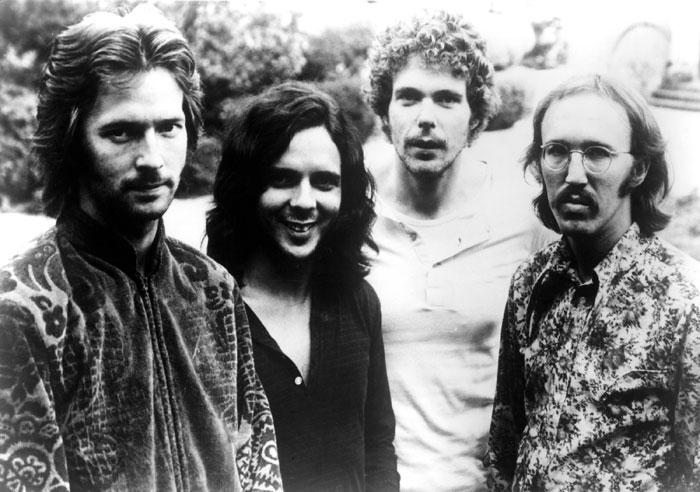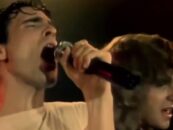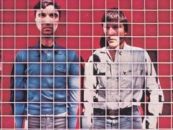 Who’s that bored-looking guy on the album cover? Sitting on a chair in a nearly empty room that seems to be in the process of decoration, his eyes look down, avoiding the camera. The cigarette in his right hand’s almost burned out, and a 1956 Fender Stratocaster with a sunburst finish leans unused against his leg. He looks to be in his mid-20s, bearded and long-haired, not unlike many of his generation in 1970, when the photo was taken. The only hint of panache is his snazzy cream-colored suit. Could this be, possibly, the Eric Clapton formerly known as God?
Who’s that bored-looking guy on the album cover? Sitting on a chair in a nearly empty room that seems to be in the process of decoration, his eyes look down, avoiding the camera. The cigarette in his right hand’s almost burned out, and a 1956 Fender Stratocaster with a sunburst finish leans unused against his leg. He looks to be in his mid-20s, bearded and long-haired, not unlike many of his generation in 1970, when the photo was taken. The only hint of panache is his snazzy cream-colored suit. Could this be, possibly, the Eric Clapton formerly known as God?
Writing in his 2007 autobiography, Clapton described what happened to him in 1969 when he discovered Delaney and Bonnie Bramlett and invited their band to open the U.S. tour for his supergroup Blind Faith: “I was lost in Blind Faith. I was the man in the hallway who has come out of one door, only to find it has closed behind him while another one is opening. Through that door were Delaney & Bonnie.” Bonnie was the daughter of an Illinois steelworker, and Delaney was raised in Mississippi, steeped in gospel and blues. The first white act signed to Memphis’ Stax label, D&B filled their band with stellar musicians (drummer Jim Gordon, saxophonist Bobby Keys, bassist Carl Radle, trumpeter Jim Price and organist Bobby Whitlock among them), and were key to the creation of both Clapton’s debut solo album and the other album he issued in 1970, Layla and Other Assorted Love Songs.
Listen to “After Midnight”
At loose ends after Blind Faith folded after a single album and tour, in late ’69 Clapton signed on as a touring member of Delaney and Bonnie and Friends, enjoying the easygoing collaboration and “sheer joy of playing,” and the relative anonymity it afforded him as a sideman on stage. Early in the new year he began writing songs with Delaney Bramlett, which became the core of his first solo LP, which was released in July 1970. Later that year he also wrote with Whitlock in England, eventually recording those songs in sessions with Duane Allman and most of the same musicians, dubbing the group Derek and the Dominos (more anonymity, which his record company had to counter by belatedly printing up “Derek is Eric” buttons). “I’ll never be able to repay Delaney for his belief in me,” Clapton later wrote. “He saw something I had stopped looking for in myself.”
Clapton had found new confidence in his singing, Delaney encouraging him with a sentence that stunned Eric: “God has given you this gift, and if you don’t use it He will take it away.” Mostly recorded at Village Recorders in Los Angeles when Clapton was staying at Delaney and Bonnie’s Sherman Oaks, California, house, some of the tunes were spontaneous creations: One day when nothing particular was planned, Leon Russell gave Clapton a line about how people viewed him, an idea that became “Blues Power,” with its opening lines, “I bet you didn’t think I knew how to rock and roll/Oh, I got the boogie-woogie right down in my very soul.” Clapton liked the informal atmosphere: “When I am trying to write songs, I like to leave things as unfinished as I can, so that whoever I am going to play the song with has a chance to influence, by the way they play it, the way the song will end up,” he later explained.
Still, the album is a sometimes uneasy blend of self-effacement and frontman swagger. Bramlett’s production and arrangements are dominant, and the disc sounds very much like the Delaney and Bonnie albums that preceded it. Clapton eschews the long, expeditionary solos he was known for, and keeps it succinct. Strangely, the opener, “Slunky,” is an energetic but simple instrumental jam led by Keys’ sax and Russell’s funky piano, with a so-so, somewhat clichéd, tinny-sounding Clapton solo. Why this was deemed worthy of starting such an important album is a mystery—Clapton doesn’t command the track or make it focus. Likewise, the following “Bad Boy” is a fairly standard blues written by Bramlett and Clapton, but it does have an excellent horn arrangement and biting guitar solos, fading out on what seems to be a brief Delaney-Clapton duel.
Related: Clapton and others paid tribute to the late Ginger Baker in a London concert
“Lonesome and a Long Way From Home,” written by Delaney and Russell, is the first real delight of the album, with a storming horn arrangement, excellent drumming from Gordon and a wonderfully prominent gospel chorus (with Bonnie Bramlett and Rita Coolidge) backing up a confident Clapton vocal. It’s very much in the style of Delaney and Bonnie’s best recordings, with a focused, lightly wah-wahing Clapton solo.
J.J. Cale’s “After Midnight,” with a driving march rhythm from Gordon, has rightly earned its iconic status as one of rock’s greatest recordings. The gospel chorus echoes Clapton, and his solo is precise and concise. Issued as the album’s lead single, it made the top 20 on Billboard’s singles chart and powered the LP, which debuted on the album chart on Aug. 1, to a high of #13. (In 2006 Clapton and Cale finally issued a long-planned duo album, The Road to Escondido, which won them a Grammy.)
After the rather tepid self-penned ballad “Easy Now,” in which Clapton fairly obviously imitates his friend George Harrison, “Blues Power” brings the first side of the LP to an end. Here, everything comes together: fantastic guitar playing, a versatile vocal that ranges from grit to falsetto and another tremendous arrangement that bears the fingerprints of Leon Russell (with some bumping stop-start effects). If “Blues Power” had been placed first on the side, it would have blown listeners away from the start—as it is, it’s well-placed to make you want to turn the vinyl over.
The shuffle “Bottle of Red Wine” begins side two, with Bonnie and Clapton duetting to fine effect and Clapton’s guitar tone the clearest on the album. The track has a great spontaneous feel, thanks especially to Bonnie’s wailing fills. “Lovin’ You Lovin’ Me” and “Told You For the Last Time” (a Delaney co-write with Steve Cropper) are mid-tempo, country-gospel-flavored tunes, with perfectly good Clapton vocals in service of second-tier songs.
After that, the album ends very strongly, with the R&B love song “Don’t Know Why” (Clapton’s guitar interjections are primo) and “Let It Rain,” which stretches out to over five minutes (the longest on the album). The track has a killer guitar figure to kick it off, and contains several very different instrumental sections, one of which features Stephen Stills’ guitar and has a hint of Buffalo Springfield. Clapton’s guitar work is closer to Blind Faith than anywhere else on the LP. “Let It Rain” wasn’t released as a single until 1972, and only barely scraped into the top 50, but it’s become a radio staple.
Despite his crucial participation, Delaney’s original sound mixes were rejected in favor of those by Atlantic’s in-house star producer Tom Dowd. Bramlett’s were finally released in 2006 as part of a “deluxe edition” double-CD, and contain their own delights and surprises, including a smashing “Blues Power” that bests the Dowd version. In the wake of the album’s modest commercial success, the worldwide “Clapton is God” graffiti probably diminished a bit. From Clapton’s point of view, that was “mission accomplished.”
The album received an expanded edition in 2021. Clapton, who turned 78 on March 30, 2024, continues to perform. [Tickets are available here.]
Listen to a live version of “After Midnight” performed by Clapton and Steve Winwood
The album, and other recordings in his extensive catalog, are available in the U.S. here and in the U.K. here.








11 Comments so far
Jump into a conversationThat undated black and white picture from the 70’s is from January 1973 Rainbow concert. Second person in picture is bassist Ric Grech who died in March 17 1990.
I got the album when it was released, hoping and expecting that Delaney and Bonnie was behind him. My impression at the time was it was an overproduced mess, with weak song writing and uninspired guitar riffs. After Midnight is the best cut on the album, but a rock classic? A good look back here at a record I haven’t listened to in a long time.
Clapton wasn’t bored on the cover .He was moving in deep into Heroin addiction, not to mention cocaine use ; he’s in haze .His friend and mentor Jimi Hendrix died and he was bummed out , questioning his validity and the hype . He needed the validation from musicians he respected and though this is a “solo” album that desire for validation produced some of his best playing and the stage for the epic Layla album which was a drug fueled masterpiece and as many noted driven by the great musicians from this album. The live Derek and the Dominos has Clapton going through the motions …Duane had died , and Carl Radle wasn’t far behind , in fact taking a look at the Dominos few survived unscathed…..Clapton faded into deep addiction and he produced a lot of crap because of it.
When Clapton’s solo debut was released in July 1970 Jimi wasn’t dead yet. Derek And The Dominos were already break up when Duane died. Carl Radle’s dead was far away because he died about ten years later when this album was released. Lot of crap? It wasn’t possible because next studio album he released after Layla was 461 Ocean Boulevard in 1974!
I was being charitable (and I hoped a bit humorous) while trying to assess Eric’s state of mind during the photo shoot. I could have mentioned his drug problems, but it seemed like such a big subject on its own.
Slunky sets the tone for the album; without using words it says’ betcha didnt think I knew how to rock and roll’! The sax is the big thing at first; this is a Clapton song? When he slices thru the song with a searing hot opening salvo of licks and that funky backbeat you are burning along with the spacey reverb echo chamber effect. Claptons solos often begin like they are already in full tilt with just a few bends and streching that neck. In Slunky I hear something that could have been from.the fifties and a jazzy swing feel. The sax and ax alternate in and out of fervor and fade . The star of the song is ‘Blackie’; EC’s ax he built out of at least 4 guitars. That Fat Strat So u nd is the def of the word Slunky. Sounds like something Bobby Whitlock would say; and probably did. His role in EC’s solo debut and The Dominoes is essential. That Southern boy along of course with Delaney showed EC that white boys were taking the music and doing their thing to it. Like EC had done in his English way with the blues. They alls be wannabe wiggahs! Rock and Soul Music! Can we steal the black mans music and get rich doung it? Hell yeah boy! Where would Clapton have ever become the icon without his Blues Breakers days? Cream was a vehicle for Clapton with two jazz influenced dudes that sent Eric into new areas besides blues.The Band’s influence on so many was a big thing at that moment and EC was heavily affected by them. There was a lot going on in 1969 and this album was a huge deal. Eric Clapton singing? Or is that Delaney Bramlett? Erics voice is like no other and the last 50 years has resonated with his voice; and his guitar… his other voice.
He didn’t have Blackie yet. It is a great Strat sound, but this is Brownie, the 1956 Strat he purchased when he still was in Cream.
Mark, I don’t know how you can blow off “Easy Now” so easily. It’s quite possible that EC was influenced by his friend, but so what? Obviously, all these folks were influencing each other in this heady time of great music. That song was the first of another side of many similar more tender songs that Clapton would write in the years to come. As for the LP itself, as a huge fan in those days, I really wanted to like it, but ultimately have to admit that, for so many reasons, it is unsatisfying. For one thing, aside from the uneven song writing, Clapton’s insistence on using that between phase strat tone throughout the record gets old. I guess while Tom Dowd could remix the tracks, there wasn’t anything he could do about Clapton’s consistently thin tone that was already laid down. A little of that might have added some character to a song or two, but to have be your tone for the whole LP of your first solo record is just foolish. In my opinion, “Layla” is really the only great record that Clapton ever made, of his own records. He really is at his best as a collaborator, and get’s pretty boring and predictable on his own. That’s why he was at his best with Cream.
By the way, I believe that is Clapton singing both parts on “Red Wine,” not Clapton singing a duet with Bonnie Bramlett.
I bought this album in Dallas when I was 15 in ’70. What an inspiration for a young guitar player. When I got Layla I thought ‘This must be the best album ever made’
Im old enough when Eric was playing with the Bluesbreakers and Yardbirds. Amazing raw playing. Didnt see how he could top that that. Then Cream, he did. Blind Faith,tried didn’t. He peaked early.His bands since never pushed him like Jack and Ginger. Having said that I will see Eric again in the fall of 2024.